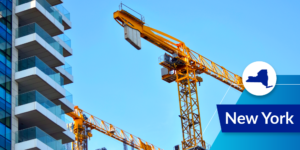
New York City tax-incentive subsidy 421a — the highest property tax break in the city, which has subsidized the construction of countless apartments and other multi-family housing complexes — expired on June 15, 2022, leaving industry professionals unsure as to how construction may change in the area.
The impact won’t be felt immediately, as the June 15 deadline maintains that eligible projects need to be finished on or before June 15, 2026. But while multi-family construction may perk up in the city again soon, it’s likely that it won’t be an immediate revival.
Industry leaders noted that the number of applications for new multi-family housing buildings may plunge in the short term as those who missed the deadline to apply for 421a hold back in preparation for what may come in the future.
“I think there is going to be a pause,” says lawyer Erica Buckley. Much the same thing happened in 2016, the last time that 421a lapsed, before it was approved to return in 2017. “You are definitely going to have a wait-and-see moment.”
A report from the Community Service Society of New York maintains that the program actually is “uniquely bad at producing affordable housing,” claiming that the program’s goals generally result in housing that “in many neighborhoods, is both too expensive for most neighborhood residents and more expensive than market-rate units for rent nearby.”
Data from New York University’s Furman Center for Real Estate and Urban Policy showed that the types of apartments built under 421a haven’t been evenly distributed, with larger apartments “disproportionately” going to higher-income tenants — meaning that larger support may be for looking at how the program can be re-worked in the future rather than just brought back as-is.
“A lot of people have very serious reservations about 421a as currently constituted,” said City Assemblyman Jeffrey Dinowitz. “We should do things with affordable housing, but I just don’t think we’re getting our money’s worth with 421a.”
Lawyer William Saya noted that lawmakers haven’t seen 421a as a long-term solution for the city, with it mainly being meant to combat the fact that multifamily properties are taxed at higher rates than other properties in New York City, and its lapse leaves a significant hole in this area of construction. “Everyone recognizes there’s a problem,” he added, “and yet nothing really is getting done.”
“It’s not like losing this will help make the city more affordable,” said Matt Murphy, executive director of the Furman Center. “All it does is introduce a huge amount of uncertainty in development and exacerbates the housing shortage in the long run.”
The change in dynamics in housing may play a big part in the way that construction continues in the city, as well.
“NYC went through a building boom in the late 1960s and 1970s and those buildings are now at the end of their lives,” Staikos added. “The pandemic has accelerated a flight to quality in the office sector and demand is towards newer Class A product.”
New York’s housing market has indeed been stalling, as noted in recent Levelset reporting. According to AEI Housing Center data, New York ranks 55th out of 60 metro areas in year-to-year house price appreciation, and new single-family building permits in the metro are at 1.9 per 10,000 people — among the lowest in the nation.
Read more: The 5 Best Cities for Residential Construction — and the 5 Worst
This may not just impact brand new construction, either. There are many who are unsure what the impact of the lapse of 421a will be on building conversions, which were made more financially attainable by the tax break — including the possible conversions of emptying office buildings that have continued to struggle as many employees moved to remote work.
“Converting underperforming office buildings into multifamily can reinvigorate downtowns,” said JLL Capital Markets’ Alex Staikos. “When thousands of new residents move into a particular area, you see new restaurants, shops, and entertainment venues pop up. Suddenly an underutilized pocket of the city becomes a vibrant mixed-use live/work/play community.”
For the time being, some remain optimistic about the future of development in the city — and finding a better solution than what they viewed 421a to be.
“421a is a broken, absurdly expensive Band-Aid placed on top of New York City’s broken property-tax system,” said New York City comptroller Brad Lander. “It’s good that it is not being renewed.”